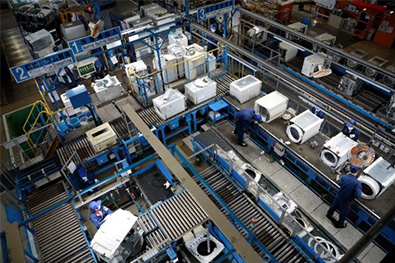Resources for our future
What comes to mind when you hear the word resources?
We use a great deal of resources in our daily lives.
Resources such as plastic, iron, and copper are used to make our everyday home appliances.
However, only a limited amount of resources remains on our planet.
Mined resources such as gold, silver, and copper, as well as fossil fuels such as oil, are becoming increasingly depleted, and moreover, their extraction results in significant environmental damage. So what actions should we take to protect our children's future?
Build up a sustainable society. This is the most important task before us.
To make careful - and repeated - use of our limited natural resources.
To enhance better recycling technologies that enable us to recycle resources from used products as much as possible.
To place maximum effort to make Resources Recycling-oriented Products from recycled resources.
Panasonic will contribute to the development of a sustainable society through such product-to-product initiatives - making effective use of our limited resources with recycling-oriented manufacturing.

Building a society that recycles resources as the norm

In order to achieve a sustainable society, we must propose initiatives that promote the recycling of our limited natural resources. Based on the simple product lifecycle shown below, Panasonic focuses on the development of products using recycled resources. We will make products, deliver them to our customers, and once they have eventually finished using them, we will extract the resources from the discarded products and reuse them to again make new products. Through these initiatives, Resources Recycling-oriented Products have been launched.
Such initiatives are only just beginning, but we plan to eventually expand this concept to every single product.
Why is resources recycling so important right now?
Many different resources are used to make each individual product. In addition to oil - the base ingredient of plastic - we are also heavily reliant on mined resources such as iron, copper, gold, and silver.
However, each of these resources is limited, and if we continue extracting them at the current rate, they will eventually run out completely.
Our approaches to recycling-oriented manufacturing
Make products from as few resources as possible. Increase the proportion of recycled resources used in the products. These are our basic approaches to recycling-oriented manufacturing. In order to reduce the amount of resources used, we are working to develop smaller, lighter product designs and to reduce the number of components in each product. Our initiatives for resources recycling also extend to a number of other areas, including the development of new recycling technologies and new ways of making products with recycled resources.
Recovering resources from usedproducts


Most of the resources used to make products can be recycled. However, for recycling, we need special technologies and highlevel sorting methods. With our facility devoted to recycling, PETEC, Panasonic is promoting various initiatives to recover and reuse resources from old products.
Understanding the importance of resources recycling
Panasonic Eco Technology Center Co., Ltd. (PETEC) in Kato city, Hyogo, Japan, was opened in April 2001 as an advanced center of operations for recycling-oriented manufacturing.
Under the concept of treasure hunting, the latest recycling technologies are deployed here to recover resources from used products and to make new products. The center also actively welcomes tour groups so that more people can use the facility as a live tool for environmental education.

Resin-sorting machine at PETEC
PETEC overview
Established: April 4, 2000
Opened: April 1, 2001
Cumulative number from 2001 to FY2025
(Appliances recycled) 19,909,244
(Factory tour visitors) 225,443
Amount of materials recycled from 2001 to FY2025
Steel 366,513t
Copper 58,078t
Aluminum 31,629t
Resin 167,050t
Recovering resources from products
Used products such as air conditioners, refrigerators, washing machine, and flatpanel televisions are all recycled in the same sequence: Dismantling by hand -> Shredding -> Sorting -> Processing.
At PETEC, special recycling technologies have been designed to recover each individual resource (such as iron, copper, and plastic) from the used products.

Incorporating ideas from the recycling factory in manufacturing operations
In order to properly promote resources recycling, it is important to consider recycling issues when the products are first developed. We communicate a variety of know-how and key observations to our product development sites - covering issues such as reducing the number of components or different materials, using eco-friendly and easy-torecycle materials, and designing products for easier dismantling.

Training of design for recycling
Making new products from recycled resources

Panasonic is developing technologies to make new products from recycled resources. For example, molding technologies for equipment to sort out various types of plastics, as well as for reusing sorted-out plastics in new products. Another example is technologies to develop complex resin where cellulose fibers derived from plants are added as raw materials. We will continue developing new technologies that can reuse recycled resources more and effectively.
Related Links


